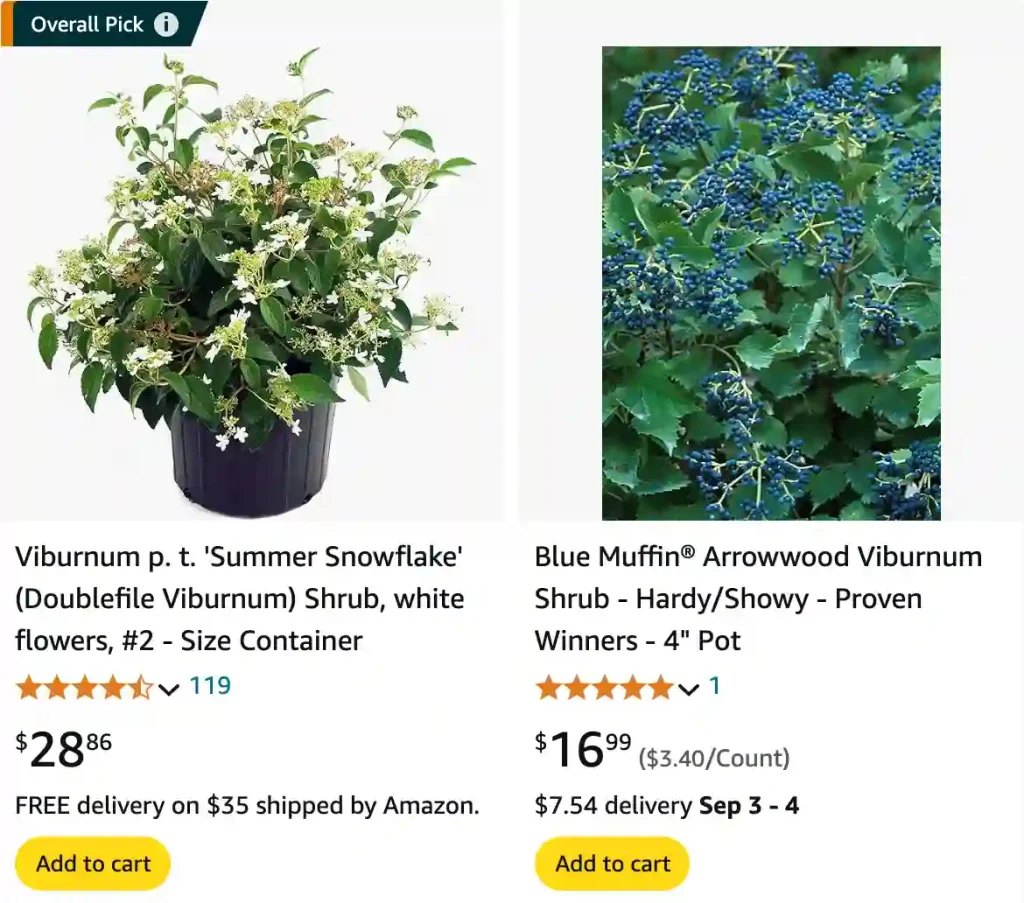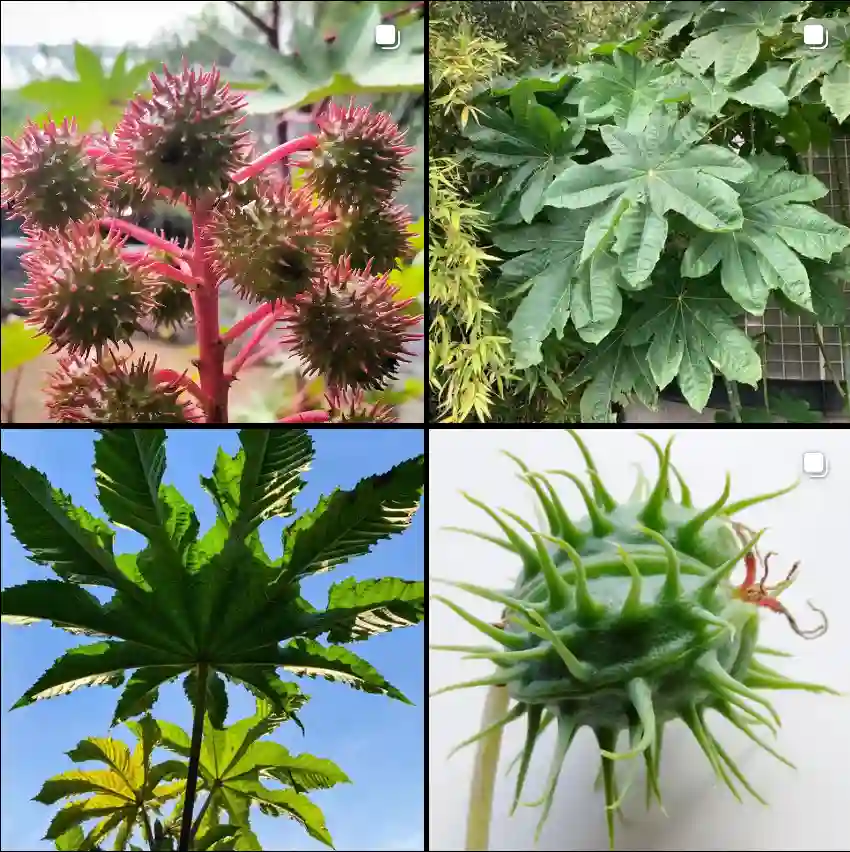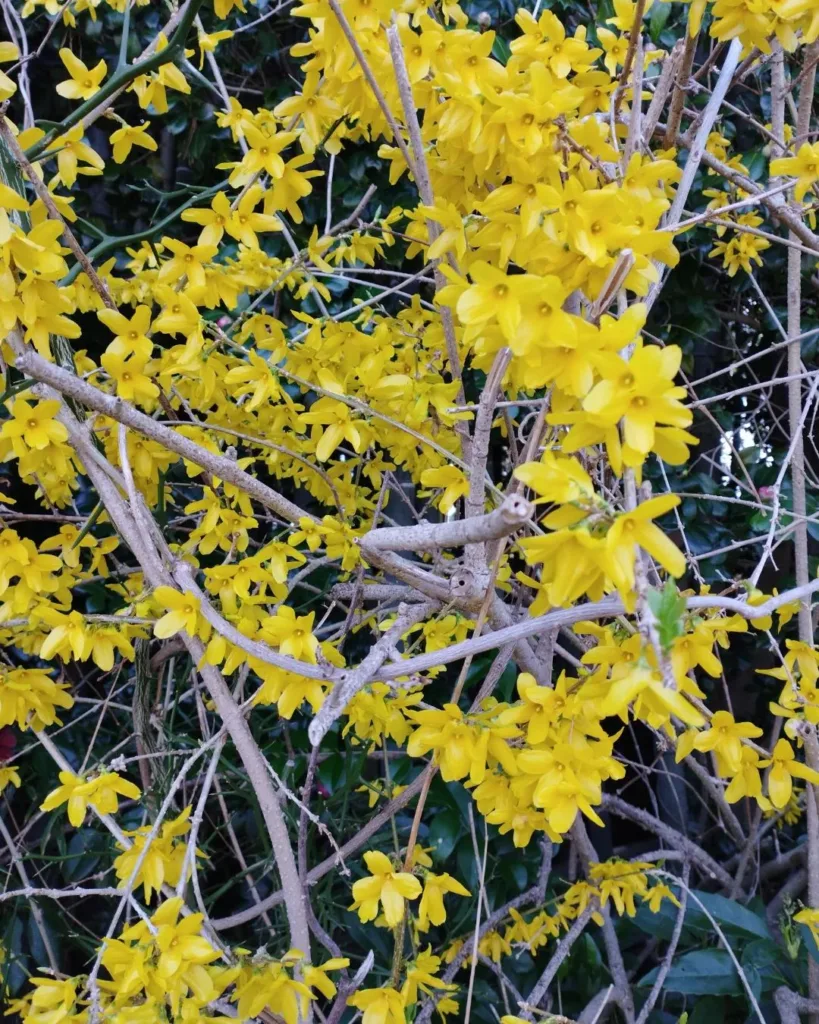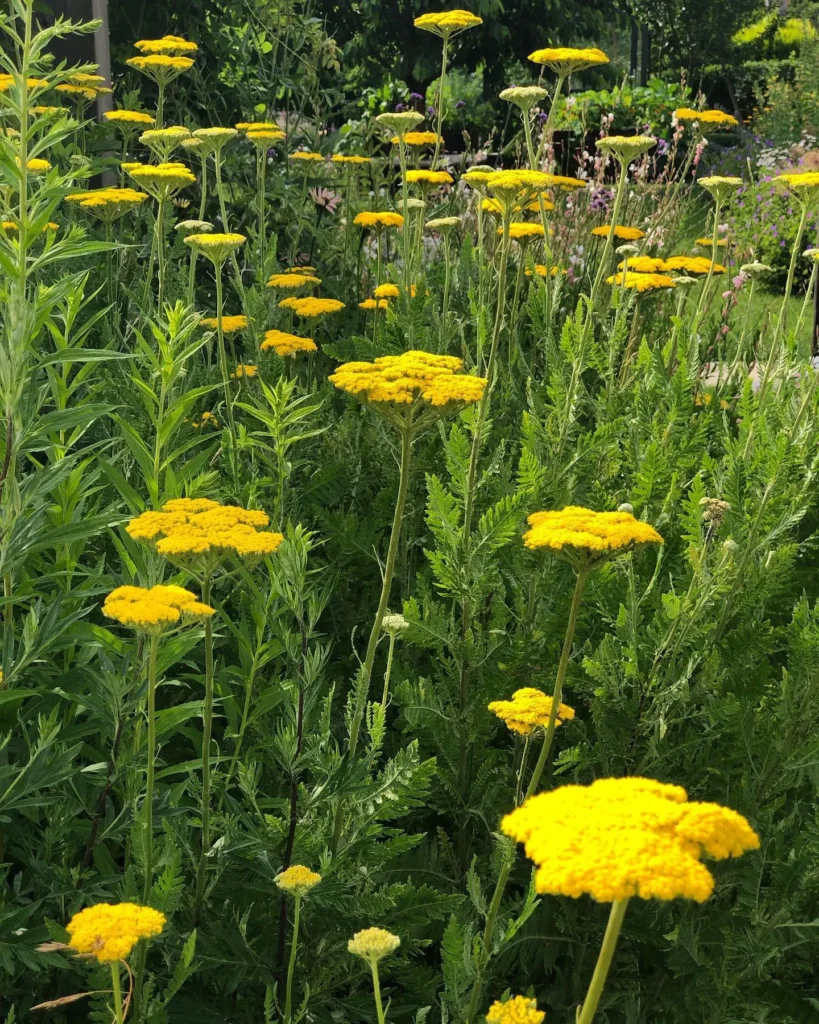
Viburnum: FAQs and Essential Tips for Gardeners
When it comes to versatile and hardy shrubs in the garden, Viburnum from the Viburnaceae family is one of my favorites. Over the years, I’ve had the pleasure of working with various Viburnum species, each bringing its unique charm and challenges. In this article, I’ll answer some of the most frequently asked questions about Viburnum, sharing my experiences and tips to help you get the best out of these wonderful plants.
Viburnum species
- Viburnum acerifolium L. Plant FAQs: Viburnum Acerifolium – Maple Leaf Viburnum
- Viburnum acutifolium Benth.
- Viburnum alabamense (McAtee) Sorrie
- Viburnum albopedunculatum Gilli
- Viburnum amplificatum J.Kern
- Viburnum amplifolium Rehder
- Viburnum anabaptista Graebn.
- Viburnum annamensis Fukuoka
- Viburnum antioquiense Killip & A.C.Sm.
- Viburnum arboreum Britton
- Viburnum atrocyaneum C.B.Clarke
- Viburnum australe C.V.Morton
- Viburnum awabuki K.Koch Plant FAQs: Viburnum Awabuki
- Viburnum ayavacense Kunth
- Viburnum beccarii Gamble
- Viburnum betulifolium Batalin
- Viburnum blandum C.V.Morton
- Viburnum boninsimense (Makino) Koidz. ex Nakai
- Viburnum brachyandrum Nakai
- Viburnum brachybotryum Hemsl.
- Viburnum bracteatum Rehder
- Viburnum brevitubum (P.S.Hsu) P.S.Hsu
- Viburnum buddleifolium C.H.Wright
- Viburnum burejaeticum Regel & Herder
- Viburnum carlesii Hemsl.
- Viburnum carolinianum Ashe
- Viburnum cassinoides L.
- Viburnum caudatum Greenm.
- Viburnum chingii P.S.Hsu
- Viburnum chinshanense Graebn.
- Viburnum chunii P.S.Hsu
- Viburnum ciliatum Greenm.
- Viburnum cinnamomifolium Rehder
- Viburnum clemensiae J.Kern
- Viburnum colebrookeanum Wall. ex DC.
- Viburnum congestum Rehder
- Viburnum coriaceum Blume
- Viburnum cornutidens Merr.
- Viburnum corylifolium Hook.f. & Thomson
- Viburnum corymbiflorum P.S.Hsu & S.C.Hsu
- Viburnum corymbosum Urb.
- Viburnum costaricanum (Oerst.) Hemsl.
- Viburnum cotinifolium D.Don
- Viburnum cubense Urb.
- Viburnum cylindricum Buch.-Ham. ex D.Don
- Viburnum dalzielii W.W.Sm.
- Viburnum dasyanthum Rehder
- Viburnum davidii Franch. Plant FAQs: Viburnum Davidii
- Viburnum deamii (Rehder) Bush
- Viburnum dentatum L. Plant FAQs: Viburnum Dentatum – Arrowwood Viburnum
- Viburnum dilatatum Thunb. Plant FAQs: Viburnum Dilatatum
- Viburnum discolor Benth.
- Viburnum disjunctum C.V.Morton
- Viburnum divaricatum Benth.
- Viburnum edule (Michx.) Raf.
- Viburnum elatum Benth.
- Viburnum ellipticum Hook.
- Viburnum erosum Thunb.
- Viburnum erubescens Wall. ex DC.
- Viburnum euryphyllum Standl. & Steyerm.
- Viburnum fansipanense J.M.H.Shaw, Wynn-Jones & V.D.Nguyen
- Viburnum farreri Stearn Plant FAQs: Viburnum Farreri
- Viburnum fengyangshanense Z.H.Chen, P.L.Chiu & L.X.Ye
- Viburnum floccosum Killip & A.C.Sm.
- Viburnum foetidum Wall.
- Viburnum fordiae Hance
- Viburnum formosanum (Hance) Hayata
- Viburnum fragile Killip & A.C.Sm.
- Viburnum furcatum Blume ex Maxim.
- Viburnum garrettii Craib
- Viburnum glaberrimum Merr.
- Viburnum glabratum Kunth
- Viburnum glomeratum Maxim.
- Viburnum goudotii Killip & A.C.Sm.
- Viburnum grandiflorum Wall. ex DC.
- Viburnum griffithianum (Kurz) C.B.Clarke
- Viburnum hainanense Merr. & Chun
- Viburnum hallii (Oerst.) Killip & A.C.Sm.
- Viburnum hanceanum Maxim.
- Viburnum harryanum Rehder
- Viburnum hartwegii Benth.
- Viburnum hayatae I.M.Turner
- Viburnum hebanthum Wight & Arn.
- Viburnum hengshanicum Tsiang
- Viburnum henryi Hemsl.
- Viburnum hispidulum J.Kern
- Viburnum × hizenense Hatus.
- Viburnum hoanglienense J.M.H.Shaw, Wynn-Jones & V.D.Nguyen
- Viburnum hondurense Standl.
- Viburnum hupehense Rehder
- Viburnum incarum Graebn.
- Viburnum inopinatum Craib
- Viburnum jamesonii (Oerst.) Killip & A.C.Sm.
- Viburnum japonicum (Thunb.) Spreng.
- Viburnum jelskii Zahlbr.
- Viburnum jucundum C.V.Morton
- Viburnum junghuhnii Miq.
- Viburnum kansuense Batalin
- Viburnum kerrii E.T.Geddes
- Viburnum × kiusianum Hatus.
- Viburnum koreanum Nakai
- Viburnum lancifolium P.S.Hsu
- Viburnum lantana L. Plant FAQs: Viburnum Lantana
- Viburnum lantanoides Michx.
- Viburnum lasiophyllum Benth.
- Viburnum laterale Rehder
- Viburnum lautum C.V.Morton
- Viburnum lehmannii Killip & A.C.Sm.
- Viburnum leiocarpum P.S.Hsu
- Viburnum lentago L. Plant FAQs: Viburnum Lentago – Nannyberry Viburnum
- Viburnum lobophyllum Graebn.
- Viburnum loeseneri Graebn.
- Viburnum longipedunculatum (P.S.Hsu) P.S.Hsu
- Viburnum longiradiatum P.S.Hsu
- Viburnum lutescens Blume
- Viburnum luzonicum Rolfe
- Viburnum macdougallii Matuda
- Viburnum macrocephalum Fortune
- Viburnum mathewsii (Oerst.) Killip & A.C.Sm.
- Viburnum meiothyrsum Diels
- Viburnum melanocarpum P.S.Hsu
- Viburnum microcarpum Schltdl. & Cham.
- Viburnum microphyllum (Oerst.) Hemsl.
- Viburnum molinae Lundell
- Viburnum molle Michx.
- Viburnum mongolicum (Pall.) Rehder
- Viburnum mortonianum Standl. & Steyerm.
- Viburnum mullaha Buch.-Ham. ex D.Don
- Viburnum nervosum D.Don
- Viburnum nitidum Aiton
- Viburnum nudum L.
- Viburnum obovatum Walter
- Viburnum obtectum J.H.Vargas
- Viburnum obtusatum D.N.Gibson
- Viburnum odoratissimum Ker Gawl. Plant FAQs: Viburnum Odoratissimum
- Viburnum oliganthum Batalin
- Viburnum omeiense P.S.Hsu
- Viburnum opulus L.
- Viburnum orientale Pall.
- Viburnum parvifolium Hayata
- Viburnum phlebotrichum Siebold & Zucc.
- Viburnum pichinchense Benth.
- Viburnum pilushanicum S.S.Ying
- Viburnum platyphyllum Merr.
- Viburnum plicatum Thunb. Plant FAQs: Viburnum Plicatum
- Viburnum propinquum Hemsl.
- Viburnum prunifolium L.
- Viburnum punctatum Buch.-Ham. ex D.Don
- Viburnum pyramidatum Rehder
- Viburnum queremalense Cuatrec.
- Viburnum rafinesqueanum Schult.
- Viburnum recognitum Fernald
- Viburnum rhytidophyllum Hemsl. Plant FAQs: Viburnum Rhytidophyllum – Leatherleaf Viburnum
- Viburnum rufidulum Raf. Plant FAQs: Viburnum Rufidulum – Rusty Blackhaw Viburnum
- Viburnum rugosum Pers.
- Viburnum sambucinum Reinw. ex Blume
- Viburnum sargentii Koehne
- Viburnum scabrellum (Torr. & A.Gray) Chapm.
- Viburnum schensianum Maxim.
- Viburnum seemenii Graebn.
- Viburnum sempervirens K.Koch
- Viburnum setigerum Hance
- Viburnum shweliense W.W.Sm.
- Viburnum sieboldii Miq.
- Viburnum spruceanum Rusby
- Viburnum squamulosum P.S.Hsu
- Viburnum stellatotomentosum (Oerst.) Hemsl.
- Viburnum stenocalyx (Oerst.) Hemsl.
- Viburnum stipitatum J.H.Vargas
- Viburnum subalpinum Hand.-Mazz.
- Viburnum subpubescens Lundell
- Viburnum subsessile Killip & A.C.Sm.
- Viburnum sulcatum (Oerst.) Hemsl.
- Viburnum suratense Killip & A.C.Sm.
- Viburnum suspensum Lindl. Plant FAQs: Viburnum Suspensum
- Viburnum sympodiale Graebn.
- Viburnum taitoense Hayata
- Viburnum taiwanianum Hayata
- Viburnum tashiroi Nakai
- Viburnum tengyuehense (W.W.Sm.) P.S.Hsu
- Viburnum ternatum Rehder
- Viburnum tiliifolium (Oerst.) Hemsl.
- Viburnum tinoides L.f.
- Viburnum tinus L.
- Viburnum toronis Killip & A.C.Sm.
- Viburnum trabeculosum C.Y.Wu
- Viburnum treleasei Gand.
- Viburnum tricostatum C.E.C.Fisch.
- Viburnum tridentatum Killip & A.C.Sm.
- Viburnum trilobum Marshall Plant FAQs: Viburnum Trilobum – American Cranberry Bush
- Viburnum triphyllum Benth.
- Viburnum triplinerve Hand.-Mazz.
- Viburnum undulatum (Oerst.) Killip & A.C.Sm.
- Viburnum urbani Graebn.
- Viburnum urceolatum Siebold & Zucc.
- Viburnum utile Hemsl.
- Viburnum venosum Britton
- Viburnum venustum C.V.Morton
- Viburnum vernicosum Gibbs
- Viburnum villosum Sw.
- Viburnum wardii W.W.Sm.
- Viburnum weberbaueri Graebn.
- Viburnum witteanum Graebn.
- Viburnum wrightii Miq.
- Viburnum wurdackii T.R.Dudley
- Viburnum yunnanense Rehder
When to Prune Viburnum?
Pruning Viburnum is essential to maintaining its shape and promoting healthy growth. The best time to prune Viburnum is immediately after it has finished blooming in late spring or early summer. This timing allows the plant to recover and set buds for the next year’s flowers. I usually take care not to prune too late in the season, as this can result in fewer blooms the following year. Additionally, it’s a good practice to remove any dead or damaged branches whenever you notice them, regardless of the season.
Do Deer Eat Viburnum?
Deer resistance is a common concern for gardeners, especially in areas where these animals are prevalent. From my experience, Viburnum tends to be deer-resistant, but it’s not entirely immune. Deer may nibble on new shoots or leaves, especially during times when food is scarce. However, Viburnum is generally not their first choice, making it a relatively safe option for gardens prone to deer visits.
When Do Viburnums Bloom?
One of the reasons I love Viburnum is its beautiful blooms, which usually appear in late spring to early summer. The exact timing can vary depending on the species and local climate. For example, Viburnum plicatum blooms earlier in the season, while Viburnum dentatum might bloom slightly later. The clusters of white or pink flowers are not only visually appealing but also attract a variety of pollinators to the garden.
How Fast Does Viburnum Grow?
The growth rate of Viburnum varies by species. In general, they are moderate to fast growers. On average, you can expect a Viburnum to grow between 12 to 24 inches per year. Species like Viburnum trilobum and Viburnum dentatum are known for their relatively fast growth, which makes them ideal for creating privacy screens or hedges in a short period. Proper care, including adequate watering and fertilization, can enhance the growth rate.
When to Cut Back Viburnum?
Cutting back Viburnum is often necessary to control its size and shape, especially in a formal garden setting. The best time to cut back Viburnum is in late winter or early spring before new growth begins. This timing minimizes stress on the plant and encourages a flush of new growth in the growing season. I usually cut back about one-third of the oldest stems to the ground to rejuvenate the plant and keep it healthy.
Are Viburnum Berries Edible?
Viburnum berries are a topic of much curiosity. While some Viburnum species produce berries that are edible, others can be mildly toxic. For example, the berries of Viburnum opulus (also known as European Cranberrybush) are edible when cooked, but they are very bitter when raw. On the other hand, the berries of Viburnum tinus are generally considered inedible due to their bitter taste. It’s always best to research the specific species in your garden before consuming any part of the plant.
How to Propagate Viburnum?
Propagating Viburnum is a rewarding process, and I’ve had success using both cuttings and layering methods. For cuttings, I usually take semi-hardwood cuttings in late summer, dipping them in rooting hormone before planting them in a well-draining potting mix. Keep the cuttings moist and in indirect light until they root, which can take a few weeks. Layering is another method where you bend a low branch to the ground, cover it with soil, and wait for it to root before cutting it from the parent plant.
Is Arrowwood Viburnum Invasive?
Arrowwood Viburnum (Viburnum dentatum) is a native plant in many parts of North America, and while it can spread, it’s not typically considered invasive. It spreads through suckering, where new shoots emerge from the base of the plant, forming a dense thicket over time. In managed garden settings, regular pruning can keep this in check. However, in wild or untended areas, it can become somewhat aggressive.
Viburnum vs. Hydrangea
When comparing Viburnum and Hydrangea, it’s essential to consider your garden’s needs. Viburnum is generally hardier and less demanding than Hydrangea, making it easier to care for. While both shrubs offer stunning blooms, Hydrangea’s flowers are more prominent and come in a wider range of colors, depending on soil pH. On the other hand, Viburnum provides the added benefit of attractive berries and fall foliage.
Viburnum vs. Dogwood
Viburnum and Dogwood are both excellent choices for adding year-round interest to the garden. Dogwood, particularly the red-twig variety, shines in the winter with its vibrant red stems, while Viburnum offers a more subtle beauty with its evergreen foliage and clusters of berries. If you’re looking for a plant that requires less maintenance, Viburnum is the better choice, as Dogwood can be more susceptible to diseases and pests.
Viburnum vs. Elderberry
Elderberry and Viburnum both produce berries that are loved by birds, but they serve different roles in the garden. Elderberry grows faster and can become quite large, making it ideal for naturalizing or creating wildlife habitats. Viburnum, with its slower growth and more compact form, is better suited for ornamental purposes. Additionally, Elderberry requires more space and moisture, whereas Viburnum is more adaptable to various soil types.
Viburnum vs. Ligustrum
Ligustrum, also known as Privet, is often compared to Viburnum for hedging purposes. While both plants are evergreen and can be used for privacy screens, Viburnum generally has more ornamental appeal with its flowers and berries. Ligustrum, however, grows faster and is more tolerant of severe pruning, making it a better choice for formal hedges that require frequent shaping.
Viburnum vs. Lilac
Lilac and Viburnum are both cherished for their fragrant blooms, but they have different growing requirements. Lilacs prefer full sun and alkaline soil, while Viburnum is more adaptable to different soil types and can tolerate some shade. If you’re in a region with hot summers, Viburnum might be the better option, as Lilacs can struggle in the heat.
Viburnum vs. Spirea
Spirea and Viburnum are both reliable shrubs for adding structure and beauty to the garden. Spirea is typically smaller and more compact, with a more extended blooming period, while Viburnum offers the added benefits of berries and fall color. If you’re looking for a low-maintenance shrub that requires minimal pruning, Spirea might be the better choice. However, for a more substantial impact in the landscape, Viburnum’s versatility and year-round interest are hard to beat.
What to Plant with Viburnum?
Viburnum pairs beautifully with a variety of other plants. I’ve had success planting it alongside evergreens like Boxwood or Juniper, which provide a contrasting texture and color. Perennials such as Hostas or Astilbes also work well, especially in shaded areas where Viburnum thrives. For a more dynamic garden, consider planting Viburnum with spring-blooming bulbs like Daffodils or Tulips, which can add color before the Viburnum blooms.
Common Problems with Viburnum
While Viburnum is generally easy to grow, it can face some issues. One common problem I’ve encountered is powdery mildew, especially in humid climates. Ensuring good air circulation and avoiding overhead watering can help prevent this. Another issue is aphid infestations, which can be managed with insecticidal soap or by encouraging beneficial insects like ladybugs. Regular monitoring and timely intervention are key to keeping your Viburnum healthy.
Benefits of Growing Viburnum
Growing Viburnum offers numerous benefits. It’s a versatile shrub that provides year-round interest, from its spring blooms to its fall berries and foliage. It’s also relatively low-maintenance, drought-tolerant once established, and adaptable to various soil types. Whether you’re looking for a privacy screen, a specimen plant, or a wildlife-friendly garden, Viburnum is an excellent choice.
In conclusion, Viburnum is a reliable and attractive shrub that can enhance any garden. With proper care and attention to its specific needs, you can enjoy the beauty and benefits of Viburnum for years to come.
If i die, water my plants!



